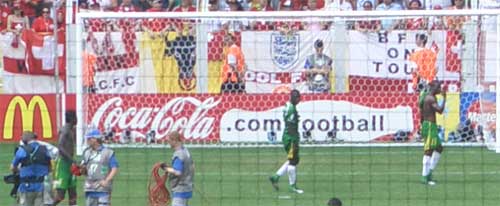"Andrés Sebastián Soria Quintana, is a naturalized Qatari footballer who plays as a striker for Lekhwiya" This is the brief introduction of Soria's profile on most websites. Sounds weird? Sebastian = a Qatari name? Well, no, he is a naturalized footballer who now plays regularly for most of Qatar's national team matches and is also extremely popular at club level football. Turns out, that he is not the only one. At a football match that I recently attended in Doha, I noticed that many players had Christian names and did not look Arab as well. As a student of sociology, I found this particularly interesting since one would expect to see the best local players on the national team. So how did this major change happen? and Why?

Qatar's National Football team
Club football has contributed a lot to the exchange of players globally. Today, most major clubs world over have international players coming across the border to play for them. The major reasons for this of course are the financial benefits that they may receive and also, the feeling of being associated with a top of the league club. Globalization has had a huge impact on the sports arena. Players, professionals, staff, money and brands have all been and continue to be exchanged across borders at high levels. Football , or Soccer, has always been the number one sport in terms of fan following, television rating points and investments. As an effect of globalization, several players moved to different parts of the world where their talent could be harnessed and they had better opportunities to make money and develop professionally.
The idea of capitalism is of course at the heart of all this change. Club football is probably one of the highest revenue generating form of sport today. Corporations spend millions of dollars on advertising and communication so that their brand gets noticed by the majority. Most major companies like McDonalds and Coca Cola are official sponsors of world class events such as the Olympics, FIFA World Cup etc. This gives them huge exposure which of course any major corporation would love to have. Corporations are known for their extensive support when it comes to subcultures and hence, sport is a major area of interest for all the big brands in the industry today.

The usual sponsors at most events
The process of naturalization is not really new but its just that there is a lot of focus on it today since many countries are practicing it. Several countries today have naturalized players representing various national teams. In Qatar, most sports have naturalized citizens playing for them. In football, table-tennis, basketball, swimming etc. there are several players who are not originally from Qatar. While many players are born in Qatar and perhaps have lived in Qatar all their lives, they wouldn't have been granted citizenship under normal conditions. But, when it comes to sport, this exception seems to be made easily. In class this week, we discussed about variance. It is important to note here that variance can go in both directions. It doesn't necessarily have to be deviant. The idea of naturalized sports persons can also be seen as a form of variance. The team demographics in general isn't deviant in any respect, but there is a level of difference that seems significant. For instance, at the beginning of the national anthem in the Qatar-Japan game, there were hardly any Qatari players who were singing the anthem. The reason being that they probably didn't know them in the first place.
The band ready for the anthems
But this is an accepted culture in the world today. The idea of dominant culture is key here. In this case, the dominant culture is the culture of FIFA, that sets the rules and regulations for international football. Players too seem to make the shift without any major issues since ultimately they benefit the most. We discussed the idea of tribalization and de-tribalization in class last week. Given the huge financial incentives, many players don't mind de-tribalizing from their original communities and seek citizenship in other countries.
Still, for varying political reasons, FIFA has deliberately kept eligibility rules rather vague. Its Article 18 reads in full:
1. Any player who is a naturalized citizen of a country in virtue of that country’s laws shall be eligible to play for a national or representative team of that country.
This culture has been introduced and to some extent supported by FIFA and so the other countries just try to adapt and thereby take advantage of the dominant culture and make it look like they are merely adhering to the broader culture. Communication needs to be clear and definite. Statements such as these need to be more specific and clear. As per this statement, any country could grant citizenship for a period of time and have a particular player represent their country. The homology of FIFA has begun to take a different direction though. Recently, they have introduced strict regulations on the naturalization process. For instance, a player must play at least five years of club football in the country before he/she can represent the country. Qatar has done a great job with following the rules and developing a strategy. Players like Sebastian Soria and others have been around in Qatar for years and they played for Qatar only after clearing the eligibility requirements. The Qatari crowd today loves Sebastian and he is still a key performer in most matches for Qatar. The video below shows how the country embraces Sebastian as their player. Notice the commentator's support too!
While FIFA has set several regulations for this, there are other sports that continue to naturalize players for a short duration. This perhaps need to be re-thought and is in fact a complex debate since it deals with several socio-political domains such as nationality, ethnicity, religion, diplomacy, culture, belief and values. The global sporting arena would be interesting to look at in the coming years.
